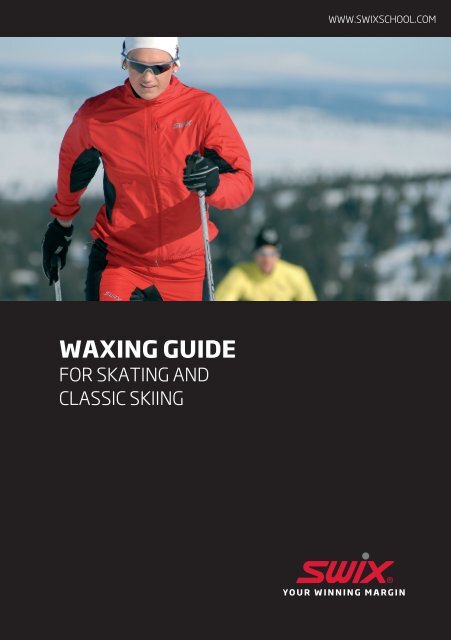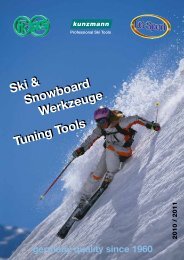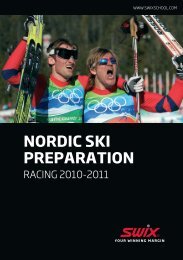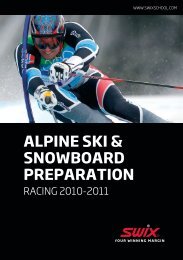WAXING GUIDE
WAXING GUIDE
WAXING GUIDE
You also want an ePaper? Increase the reach of your titles
YUMPU automatically turns print PDFs into web optimized ePapers that Google loves.
WWW.SWIXSCHOOL.COM<strong>WAXING</strong> <strong>GUIDE</strong>FOR SKATING ANDCLASSIC SKIING1
This manual is not directed towards World Cup racers, but rather to frequentskiers keen to keep in shape. Follow the guidelines found in this manual andwe can promise better and more enjoyable skiing.(T769)Waxing profile with legs.Founder of Swix, Martin Matsbo (1911-2002)testing kick wax in 1946.Swix takes pride in its more than 50 year historyas one of the strongest and most recognized brandnames in skiing.(T79-1)Fibertex for removal ofoxidation on new ski bases(T266N).Waxing Iron (T74220).Base Cleaner with fibertexapplicator (I63N).Followed by pioneering research work in 1946,the Astra Pharmaceutical Company introducedrevolutionary ski waxes based upon fully syntheticmaterials. The new 3-colored system was abreak-through for all skiers, and de-mystified andsimplified waxing. The new Swix system of waxingreplaced unscientific and often secret concoctionsof tar, beeswax, melted bicycle tire inner rubes andphonograph records, to mention just a few of theobscure ingredients. Before long, Swix waxes werediscovered the world over, and recreational skiersand racers alike realized a new level of enjoymentand success.Plexi Scraper for removingglide wax (T823).Wax Scraper (T86).Bronze Brush for brushingthe glider out of the basestructure (T162).Combi Cork withsandpaper to be used onthe kick zone (T11).Fiberlene CleaningTowel (T151).Ski straps (R402).Since 1986 Swix has been located in Lillehammer,Norway where all wax production takes place.This is an ideal area for testing and developingnew products having close access to cross countrytrails and alpine areas.Traditionally famous for its XC-waxes, today Swixis also the number one alpine ski wax company.We are present at all big events on the World Cupfor cross-country, alpine and snowboard. The mostimportant markets are Japan, Russia, USA and theNordic Countries. Swix is owned by the industrialgroup FERD.Pencil groove scraper(T88).1
NEW SKATING SKIS/CLASSIC SKIS GLIDEZONESGLIDE WAX FOR THE DAY FOR SKATING SKIS/CLASSIC SKIS GLIDEZONEST266NCH10T74220T88T408T823T162B1. Base conditioningThe preparation of new skis starts with Fibertextreatment (T266N), 8-10 passes in both directionsalong the base. Polyethylene hairs and micro-burrsare removed, and the base surface is “opened” forbetter glide wax absorption.NB! Only in the glide zones.2. Hot wax cleaningCleaning by hot-waxing and scraping using asoft wax, removes dirt and saturates the base.Recommended are warm temperature waxes suchas CH10, CH8 or BP99. The temperature of thewaxing iron should not exceed 120°C.Note: No glide wax in the kick zone.3. IroningStart at the tip moving the iron towards the tail ina continuous movement to prevent overheatingof the base.4. Groove scrapingWhile the wax is still warm, remove all wax out ofthe groove and on the side-edges with the Scraper(T88). Do this before scraping the base to preventscratches if the groove scraper unintentionally happensto jump out of the groove.5. Base scrapingScrape off the wax with a sharp Plexi Scraper(T823) while the wax is still warm (wax-cleaningmethod). Do not press too hard. Keeping thescraper sharp means light strokes can be used toremove the excess wax without harming the base.T408 keeps the Plexi Scraper sharp.6. BrushingUse a Bronze Brush (T162) tip to tail 10-20 times.Note: No brushing in the kick zone.7. Finally, use a soft wax, such as CH8 or CH10, tosaturate the base to prevent dry bases and to giveoptimal glide. Repeat the process two times fromStep 2 to 6, but let the skis cool to room temperature(15 minutes), before Step 4, 5 – Scraping.Skis having a new stone grind should be tratedalso as from step 1 to 7.Three glide waxes will cover most snow conditions:CH8 (or LF8) for normal winter conditions from +1°C to -4°C (34°F to 25°F),CH10 (or LF10) for wet snow (free water), andCH7 (or LF7) for cold snow.LF waxes are fluorinated and give better glide when high humidity and in wet snow.T74220T88T408T823T162BT162B1. Base conditioningBefore the application of actual wax for the day,make 4 or 5 passes with the Bronze Brush (T162) tore-new and clean the base, ensuring maximum waxabsorption.2. Hot wax applicationSet the Waxing Iron to the recommended temperatureshown on the wax package. The waxes shouldeasily melt. Let the wax drip onto base, holding theiron approx. 5 cm above the ski.Remember: No glide waxes in the kick zone ofClassic skis!3. IroningGo from tip to tail, constantly moving the iron toprevent over-heating the base. Let the skis cool for5 to 10 minutes.4. Groove scrapingRemove all wax out of the groove with the GrooveScraper (T88).5. Base scrapingScrape the base with a sharp Plexi Scraper (T823).Do not press too hard. T408 keeps the PlexiScraper sharp.6. BrushingBrush the base with a Bronze Brush (T162) from tipto tail approx. 20 times. This will remove wax fromthe base structure (grinding pattern) to give betterglide.7. BrushingPolish with a fine Nylon Brush (T160B), 10 strokes,or use Fiberlene Cleaning Towel (T151).Note: Do not brush in the kick zone of Classicskis.2 3
SWIX GLIDE WAXESTREATMENT OF THE KICK ZONECH AND LF CATEGORIESThree glide waxes are sufficient to obtain good glide on most snowconditions: CH10 (or LF10) for very wet snow from +10°C to 0°C (50°F to32°F), CH8 (or LF8) in normal winter-conditions from +1°C to -4°C (34°Fto 25°F), and CH7 (or LF7) for colder than -4°C (25°F).Note: All Swix temperatures are air temperatures in the shade.CH7 VioletCold snow. -2°C (28°F) andcolder.Recommended iron setting: 135°C (275°F).CH8 RedFor normal winter conditions.+1°C to -4°C (34°F to 25°F).Also for saturating the bases ofnew skis. Will always improvethe glide, even beyond its idealrange.Recommend iron setting: 120°C (250°F).LF7 VioletFluorocarbon Glide Wax. -2°Cand colder (28°F and colder).For cold conditions and highhumidity.Recommended iron setting: 135°C (275°F).LF8 RedFluorocarbon Glide Wax. +1°Cto -4°C (34°F to25°F). For normalwinter conditions and high airhumidity. The fluorocarbon additivedefinitely improves glidearound the freezing point andmoist snow.Recommended iron setting: 120°C (250°F).The stiffness of the skis is very important forobtaining the combination of good glide andgood kick. Take care when selecting skis.For optimal function of the kick waxes, accuratematching of ski stiffness to skier weight is necessary.At the moment of kick, having full weight onone ski, the ski should have sufficient contact withthe snow. However, skis that are too soft will reducethe gliding properties and cause unnecessary wearof the kick wax. Reputable ski shops will have goodmethods and instruments to match ski stiffness tobody weight.KICK ZONE (KLISTER=HARD WAX)The waxing of the kick zone should take place afterfinishing the glide zones. The length of the kick zoneshould be in the range of 75 cm for both klister andhard wax. Generally the kick zone is measured fromthe heel of the binding and forward.Don’t be afraid to extend the kick zone forward ifthe skis are slipping. A longer kick zone has lessinfluence on glide than what you might imagine,and having good kick will make the ski tour muchmore enjoyable.Note: No glide wax in the kick zone!70 - 75 cmCH10 YellowFor very wet snow (free water inthe snow). +10°C to 0°C (50°F to32°F). Often used to saturate thebases of new skis due to its softnessand penetration potential.Recommended iron setting: 110°C (230°F).LF10 YellowFluorocarbon Glide Wax. +10°Cto 0°C (50°F to 32°F). For verywet snow. The fluorocarbonadditive will improve glideand increase dirt resistance.Recommended iron setting: 110°C (230°F).ski60 - 65 cm180 cmski180 cm4 5
APPLICATION OF HARD WAXESSWIX HARD WAXEST11V30VG30T74220V40VR451. SandingThe kick zone should first be sanded with #100 gritsandpaper approx. 60 cm (about 2 feet). Sand thezone back and forth parallel to the length of the ski.The Swix Combi Waxing Cork (T11) with sandpaperon one side is an ideal tool.2. Base waxAt temperatures below 0°C (32°F) a relatively hardwax, such as V30 Blue, is recommended as a basewax.Base Binder VG30 is applied as the first layerwhen the snow becomes coarser.3. Ironing base waxThe first layer of wax should be ironed intothe base. The heat will improve the bond betweenthe wax and base giving longer wear. Iron settingshould be 100°C (212°F).4. Hard wax applicationThe actual hard wax should be applied in 4-5thin layers, smoothing each layer with the cork.Above freezing and wet snow 2 layers are sufficient.Note: Leave 2 cm (1 inch) at each end of the kickzone. With corking, the wax is expanded into theseareas.The V-line is made both for racing and ski touring.The high quality is due to high-grade raw materialsand proven formulas that are continually adjustedto improve effectiveness.Along with the two temperature ranges shown onthe label are two snow-type symbols. One for newand falling snow, and one for older, fine grainedsnow.Note: All temperatures given on Swix waxesare air temperatures measured in the shade.V20 GREENV30 BLUENew fallen snow-8°C to -15°C (18°F to 5°F)Old, transformed snow-10°C to -18°C (12°F to 0°F)New fallen snow-2°C to -10°C (28°F to 14°F)Old, transformed snow-5°C to -15°C (23°F to 5°F)New fallen snow-1°C to -7°C (30°F to 19°F)Old, transformed snow-3°C to -10°C (27°F to 12°F)Waxing for new snow and fine grained snowOn new snow a harder (colder) wax is applied thanon older snow. The reason for this is that new snowcrystals are sharper and have better penetrationinto the wax giving better kick. Older snow particlesare more rounded and a softer wax is needed toget sufficient kick.Therefore Swix has introduced a system showingtwo different temperature intervals on all waxes,one for the new snow and one for the older snow.This makes it easier to find the right wax. Do not beconcerned about applying a wax that is one step“warmer” than what the temperature is indicating ifthe snow has become coarser. Normally the snowtransforms from new to fine grained after a coupleof days, although this process might happen fasterclose to 0°C (32°F).V50 VIOLETNew fallen snow0°C to -1°C (32° to 30°F)Old, transformed snow-1°C to -3°C (30°F to 27°F)New fallen snow+1°C to 0°C (34°F to 32°F)Old, transformed snow0°C to -2°C (32°F to 28°F)5. CorkingCorking in between each layer of wax.V40 BLUE EXTRAV55 RED SPECIALT10New fallen snow0°C to -3°C (32°F to 27°F)New fallen snow+3°C to 0°C (38°F to 32°F)Old, transformed snow-2°C to -6°C (28°F to 21°F)Old, transformed snow+1°C to -1°C (34°F to 30°F)V45 VIOLET SPECIALV60 RED/SILVER6 7
SWIX VR HARD WAXES (KRYSTAL LINE)• Wider ideal range• Better glide• Reduced risk oficing-upThe VR waxes are fluorinated and formulated fortop racing, but also have proved interesting for recreationaland sport skiers because of their excellentproperties, particularly around 0°C (32°F).These hard waxes are characterized by a highdegree of flexibility. Each VR-wax has two specifiedtemperature ranges, one for falling and newfallen snow, characterized by sharp snow crystalswith relatively strong penetration capacity, and onerange for older snow, when the crystals are morerounded and have less penetration power.NOTE: All Swix temperatures are air temperaturesin the shade.New fallen snow-7°C to -20°C (19°F to -4°F)Old, transformed snow-10°C to -30°C (14°F to -22°F)VR30 LIGHT BLUEDesigned for cold to extremely cold conditions.New fallen snow+1°C to 0°C (34°F to 32°F)Old, transformed snow0°C to -4°C (32°F to 25°F)VR50 VIOLETDesigned for moist to dry snow around freezing 0°C(32°F). When used below freezing, the snow mustbe transformed.New fallen snow0°C to +3°C (32°F to 38°F)Old, transformed snow+1°C to -1°C (34°F to 30°F)VR65 RED/YELLOW/SILVERFor moist snow. Excellent wax on fresh slightly wetto moist snow.New fallen snow-2°C to -8°C (28°F to 18°F)Old, transformed snow-4°C to -12°C (25°F to 10°F)VR40 BLUEFor normal, subfreezing temperatures.New fallen snow+2°C to 0°C (36°F to 32°F)Old, transformed snow0°C to -3°C (32°F to 27°F)VR55 SILVER/VIOLETFor moist snow around freezing and forolder, more coarse snow just below freezing.Perfect balance between kick and glide.New fallen snow+1°C to +3°C (34°F to 38°F)Old, transformed snow0°C to +2°C (32°F to 36°F)VR70 KLISTERWAXRed. For wet and moist new snow. Works alsoon wet transformed snow down to 0°C (32°F).Apply thicker if very wet.New fallen snow0°C to -2°C (32°F to 287°F)Old, transformed snow-2°C to -8°C (28°F to 18°F)VR45 FLEXILight violet. A flexible wax for temperatures aroundfreezing and colder.New fallen snow+2°C to 0°C (36°F to 32°F)Old, transformed snow+1°C to -2°C (34°F to 28°F)VR60 SILVERDesigned for moist snow. When used below freezinghigh humidity and transformed snow is required.New fallen snow+2°C to +5°C (36°F to 41°F)VR75 KLISTERWAX SOFTYellow. For wet snow, glazy tracks. Must be appliedevenly. To be used in maintained tracks only.8 9
APPLICATION OF KLISTERSSWIX UNIVERSAL RECREATION KLISTERSKlisters are generally used when the snow has gone through one ormore cycles of thawing and refreezing, or when very wet.T11KR20 KB201. SandingSand the kick zone with #100 sandpaper(or T11 Combi-Cork).2. Base KlisterKR20 or KB20 Green is normally chosen as the firstlayer as a base. Apply in a thin layer, just coveringthe sanding. For lower temperatures, high tear andwear conditions, or long distances always use KR20or KB20.Frozen corn (old) snowTransformed moistfine grained snowWet corn snowK21N Silver Universal Klister+3°C to -5°C (37°F to 23°F).For coarse to fine grained snow andchanging conditions around freezing.To be used on somewhat colderconditions than K22N VM UniversalKlister.Frozen corn (old) snowWet corn snowK22N VM Universal Klister+10°C to -3°C (50°F to 27°F).For coarse grained to fine grainedsnow, with an ideal range somewhatabove freezing.T742203. Ironing Base KlisterThe first layer of klister should be carefully warmedinto the base with an iron to improve the contactbetween the klister and base.Let the skis cool to room temperature.4. Klister applicationSelect and apply the klister of the day. One layernormally is enough. The product is applied in a“fish-bone” like pattern, or as a thin string on eachside of the groove.K22N5. Smoothing the KlisterDistribute evenly with the scraper, found inthe package, or with the hand.How to get good glide and great kick?Try Swix School at www.swixschool.com.T87Always available and free of charge!10 11
SWIX KR KLISTER (KRYSTAL LINE)CLEANING OF SKISA complete line of klisters, ranging from verycold and coarse snow to extreme wet conditions.Designed for top-level performance, but useful forrecreational touring skiing as well.Frozen corn (old) snowTransformed moistfine grained snowCleaning is recommended after each ski trip.1. ScrapingRemove as much wax as possible using a scraper(T87).Frozen corn (old) snowKR20 BASE KLISTERGreen. -3°C to -25°C (27°F to -13°F).High wear resistance and adhesion.To be used as a first layer as a binderfor other klisters or hard waxes in veryabrasive conditions. Can also be usedalone for icy conditions at very coldtemperatures. As a first layer klister,it should be heated into the base.Wet corn snowKR50 FLEXI KLISTERViolet. +3°C to -4°C (37°F to 25°F). Very adaptable,working on both sides of freezing. Ideallyit is best when conditions are changeable andmixed fine grained snow.T87I62T151I63N2. Final CleaningThe remainder is taken away with Wax Removerand Fiberlene (T0150). If the wax is difficult toremove, use gray Fibertex (T265) saturated in BaseCleaner.The Base Cleaner I63N has a coarse applicator thatefficiently removes klister.After the skis are cleaned, the glide sections shouldbe ironed with either BP88, CH8 or LF8 to avoid oxidationin the base. Remember never use glide waxin the kick section.Frozen corn (old) snowTransformed moistfine grained snowKR30 ICE KLISTERBlue. 0°C to -15°C (32°F to 5°F).For frozen, icy tracks in cold conditions.Can also be used as a baseklister for wet-snow klisters to improvewear.Frozen corn (old) snowWet corn snowKR35 VIOLET SPECIAL KLISTER+1°C to -4°C (34°F to 25°F).For conditions around 0°C (32°F) andslightly colder. Good mid layer klisteron top of green klister. Top klister, redor universal, will then not slide backwards.Wet corn snowKR60 VARIO KLISTERRed. +5°C to 0°C (41°F to 32°F).Created for medium wet snow.“Vario” is best on the warm sideof freezing.Wet corn snowKR70 AQUA KLISTERRed. +12°C to +2°C (52°F to 36°F).Wet snow klister. Used when the snowhas high water content such as slush,and the air temperature is well abovefreezing.Swix Base Cleaner (I64)The active ingredient in the cleaner isa low aromatic hydrocarbon with goodsolvent capacity.Citrus Solvent Base Cleaner (I74)500 ml Citrus Solvent is a 100% citrusbasedproduct, which also is a strongsolvent.Klister Scrubber (T269)Use together with Base Cleanerfor efficiently removal of klister.Fiberlene Cleaning Towel40 m.Base Cleaners and accessories forremoval of hard waxes and klistersWaxes and klisters consist of tough, rubbery, waterresistant,inert, and stable materials. This meansthat they are also difficult to remove from the skibase. Solvents are necessary for thorough basecleaning.Swix Base Cleaner and Swix Citrus Solvent are bothformulated to minimize health and fire hazards.Traditional solvents like trichloroethylene or methylenechloridewere frequently used as solvents foroils, fats and also waxes. These highly aromaticsolvents, however, are considered health hazardsand should be avoided. They are not found in theSwix wax removers.12 13
LIQUID GRIP LINEThe Swix Liquid Grip Waxes inherit their qualitiesfrom the traditional V-series of waxes including thefamous “V40 Blue Extra”. The three waxes in the GripLine are the solution for dedicated skiers demandinga fast and clean product with reliable kick qualities.The Liquid Grip Line includes V40L Blue, V50L Violetand V60L Red, and are used for new and finegrained snow conditions. These liquid V-productscome in convenient packaging.V40L Blue Grip-2°C to -15°C(28°F to 5°F).Liquid wax coveringa wide range on thecold side in new andfine grained snow conditions.70 ml/2.5 fl. oz.V50L Violet Grip0°C to -3°C(32°F to 27°F).Liquid wax covering therange on the cold sidebelow freezing in newand fine grained snowconditions.70 ml/2.5 fl. oz.V60L Red Grip0°C to +3°C(32°F to 38°F).Liquid wax coveringthe range on the warmside above freezing innew and fine grainedsnow conditions.70 ml/2.5 fl. oz.LIQUID GLIDE LINEEasy application, dries quickly and time saving!F6L Blue Glide-4°C to -15°C(25°F to 5°F).Fluorinated liquid waxwith wide range on thecold side. For all snowtypes.80 ml/2.8 fl.oz.F7L Violet Glide+1°C to -6°C(34°F to 22°F).Fluorinated liquid waxwith wide range aroundfreezing. For all snowtypes.80 ml/2.8 fl.oz.F8L Red Glide0°C to +10°C(32°F to 50°F).Fluorinated liquidwax for all wet snowconditions.80 ml/2.8 fl.oz.P R 1 0 2 5 E - ENGLISH14





